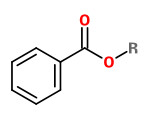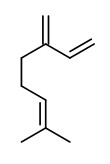Lilium longiflorum Thunb. - Liliaceae - Easter lily, white trumpet lily, Oster-Lilie
Plant up to 1m tall, native to Japan, Taiwan and Korea; leaves linear-lanceolate; flowers solitary or several, trumpet shaped, white, fragrant. Extensively cultivated worldwide as ornamental, for cut flowers (also varities, hybrids, China, US, Netherlands). wikipedia
Main components of the headspace of living Easter lily flowers were indole (19.3%), methyl benzoate (13.3%), methyl anisate (9.5%), benzyl benzoate (8.2%), benzyl salicylate (3.1%), eugenol (2.6%), methyl cinnamate (1.5%), and ethyl benzoate (0.2%).
[Mookherjee BD et al., „Fruits and Flowers: Live vs Dead - Which do we want?“, in: Nishimura, O. „Flavors and Fragrances, a world perspective.“ Proceedings of the 10th international congress of essential oils, fragrances and flavors, Washington, DC. Vol. 375. 1986, 415-424]
Floral scents emitted from eight cultivars of cut lily flowers were analyzed: „Lilies belonged to the groups of oriental hybrids (‘Siberia’, ‘Marco Polo’, and ‘Sorbonne’), OT (oriental × trumpet) hybrids (‘Yelloween’ and ‘Conca d’Or’), longiflorum hybrids (‘White Heaven’), asiatic hybrids (‘Tresor’), and LA (longiflorum × asiatic) hybrids (‘Ceb Dazzle’)…
Myrcene, (E)-β-ocimene, linalool, methyl benzoate, and ethyl benzoate were detected at high emission amounts in all scented lily cut flowers. Interestingly, 1,8-cineole was found at relatively high levels in OT hybrid lilies (‘Yelloween’ and ‘Conca d’Or’).“
Lilies belonging to the group of longiflorum hybrids (‘White Heaven’) showed (E)-β-ocimene, ethyl benzoate, methyl benzoate and linalool as main volatiles.
[Composition and emission rhythm of floral scent volatiles from eight lily cut flowers., Kong, Y., Sun, M., Pan, H.T., Zhang, Q.X., Journal of the American Society for Horticultural Science, 137(6), 2012, 376-382] PDF
 indole |  methyl benzoate (R=Me) ethyl benzoate (R=Et) |  (E)-β-ocimene |  linalool |  myrcene |
Main components of the flower scent of L.longiflorum hybrids were terpenes like β-myrcene, β-ocimene, linalool and 3-octanol.
„Terpenes and benzoic acid methyl ester were not detected from 3 lily varieties with weak aroma, while it was found that terpens were released with the highest amounts in 4 lily varieties with strong aroma. β-Ocimene and linalool were the main terpenes and may be identified as key aroma components of lily flowers.“
[Qualitative and quantitative analysis of floral volatile components from different varieties of Lilium spp., Zhang, H.X., Hu, Z.H., Leng, P.S., Wang, W.H., Xu, F., Zhao, J., Scientia Agri Sin, 46(4), 2013, 790-799]
„Nonscented lily cultivars belonging to Asiatic hybrids hardly emitted volatiles, light-scented Longiflorum × Asiatic hybrids emitted low levels of volatiles, and scented lily cultivars (belonging to Oriental, Trumpet, Longiflorum, Longiflorum × Oriental, and Oriental × Trumpet hybrids) emitted significantly high levels of volatiles. In general, the scent compositions of lily cultivars were similar within the same hybrid group, and the differences among hybrid groups reflect their pedigree. Monoterpenoids and benzenoids dominated the floral scents of most volatile-emitting lily cultivars, whereas monoterpenoids alone dominated the floral scents of some volatile-emitting lilies. Although various scent compounds were released from volatile-emitting lily cultivars, the dominant scent compounds were focused on three monoterpenoids [1.8-cineole, linalool, and (E)-β-ocimene] and one benzenoid (methyl benzoate).“
L.longiflorum hybrids 'White Present' and 'Augusta' emitted mainly (E)-β-ocimene (40.1-60.9%) and methyl benzoate (19.5-43.8%). Minor components of the scent were myrcene (2.3-4.5%), (Z)-ocimene (1.9-3.7%), linalool (2.3-2.9%), ethyl benzoate (1.3-2.6%), (E)-nerolidol (0.6-1.1%), and (E)-4,8-dimethyl-1,3,7-nonatriene (DMNT, 2.0-2.4%).
[Kong, Ying, et al. „Variation in Floral Scent Compositions of Different Lily Hybrid Groups.“ Journal of the American Society for Horticultural Science 142.3 (2017): 175-183]

Lilium longiflorum Thunb. var. suaveolens; Botanical Register, vol.7 t.560 (1822) [M.Hart] plantgenera.org

Lilium longiflorum, New Taipei City, Taiwan (2025) © lzx CC BY-SA 4.0 inaturalist.org